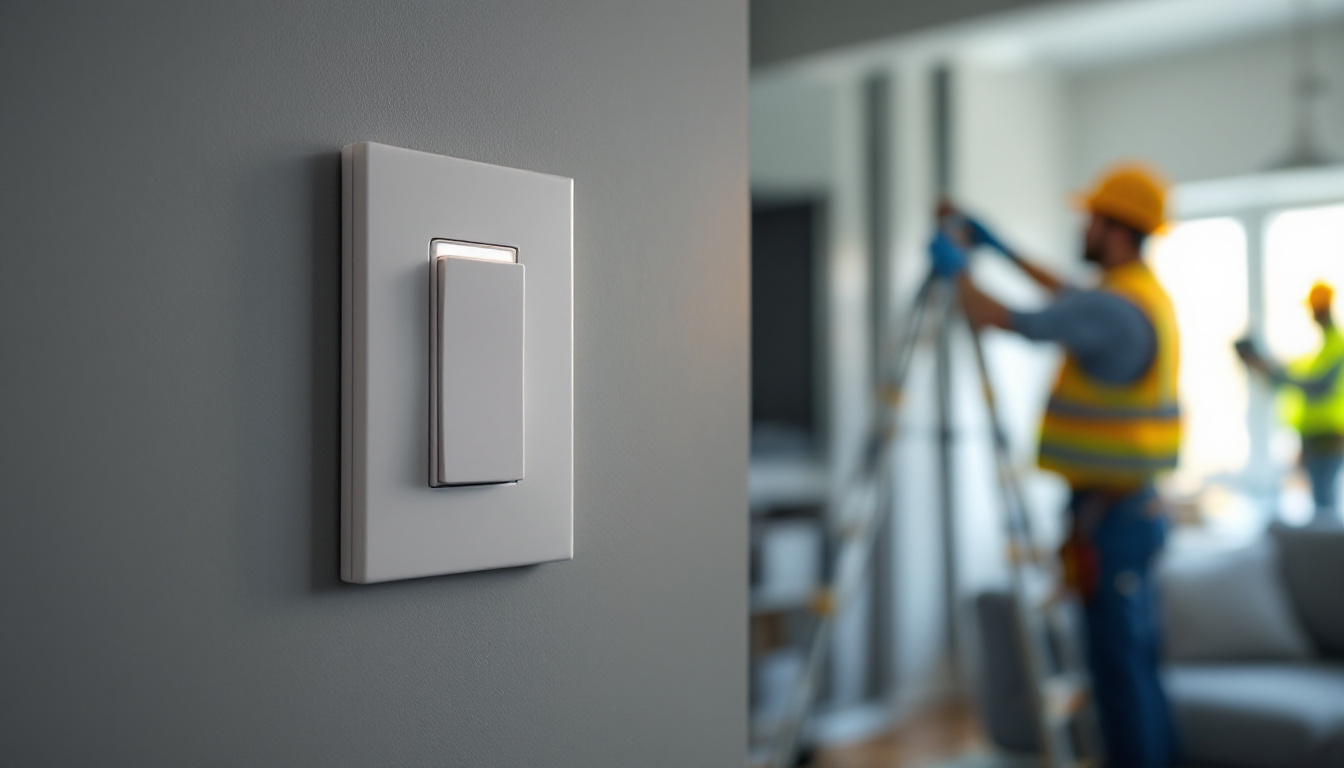

For lighting contractors, understanding the intricacies of standard light switches is crucial for both installation and troubleshooting. This article delves into the various types of standard light switches, their functionalities, and best practices for installation. By equipping yourself with this knowledge, you can enhance your service offerings and ensure client satisfaction.
At its core, a light switch is a device that controls the flow of electricity to a light fixture. The basic mechanism involves opening and closing an electrical circuit, allowing or preventing the flow of current. While this may seem straightforward, the variety of switches available can create confusion for both contractors and homeowners alike.
Standard light switches come in various styles and configurations, each designed to meet specific needs. Familiarity with these options not only aids in the selection process but also ensures compliance with electrical codes and regulations. Understanding the context in which these switches will be used is equally important, as it can influence the choice of design and functionality. For instance, in a home where children or elderly individuals reside, opting for switches that are easier to operate can enhance safety and accessibility.
The most common types of standard light switches include toggle switches, rocker switches, and dimmer switches. Each type has its unique features and applications, making it essential for contractors to understand their differences. Additionally, there are specialty switches such as three-way and four-way switches, which allow for controlling a single light fixture from multiple locations. This is particularly useful in larger homes or hallways where multiple entry points exist.
Toggle switches are the traditional style, featuring a lever that can be flipped up or down. Rocker switches, on the other hand, have a more modern design, where pressing one side turns the light on and the other side turns it off. Dimmer switches allow for adjustable lighting levels, providing flexibility in various settings. They can create ambiance in dining areas or living rooms, and are particularly beneficial in spaces where lighting needs may change throughout the day. Moreover, smart dimmer switches now integrate with home automation systems, allowing users to control lighting via smartphones or voice commands, further enhancing convenience and energy efficiency.
When selecting a light switch, it is important to consider its electrical ratings. Most standard switches are rated for 15 or 20 amps and can handle voltages of 120V. However, certain applications may require switches with higher ratings, especially in commercial settings. Understanding the load requirements of the fixtures being controlled is crucial, as using an under-rated switch can lead to overheating and potential fire hazards.
Contractors should also be aware of the materials used in switch construction. High-quality materials can enhance durability and performance, reducing the likelihood of failures or safety hazards. Always check for UL listings or other certifications to ensure compliance with safety standards. Additionally, the design of the switch can also impact its longevity; for instance, weather-resistant switches are ideal for outdoor applications, as they can withstand exposure to moisture and temperature fluctuations. As technology advances, features like LED indicators and built-in surge protection are becoming more common, offering users added functionality and peace of mind.
Proper installation of light switches is critical for functionality and safety. A well-installed switch not only operates effectively but also minimizes the risk of electrical hazards. Here are some best practices to follow during installation.
Before beginning any installation, ensure that you have the necessary tools and equipment. Common tools include a screwdriver, wire stripper, voltage tester, and electrical tape. Having the right tools on hand can streamline the installation process and reduce the risk of errors.
Additionally, using high-quality electrical components, such as wires and connectors, can enhance the overall safety and longevity of the installation. Always prioritize quality over cost when selecting materials. It’s also wise to have a flashlight handy, as it can be useful in poorly lit areas or during power outages, ensuring you can see what you’re doing without compromising safety.
1. **Turn Off Power**: Safety should always be the first priority. Before starting any electrical work, turn off the power to the circuit at the breaker box. Use a voltage tester to confirm that the power is off.
2. **Remove the Old Switch**: If replacing an existing switch, carefully remove it from the electrical box. Take note of how the wires are connected, as this will guide the installation of the new switch. If you’re unsure about the wiring, taking a photo can be a helpful reference for reinstallation.
3. **Wire the New Switch**: Connect the wires to the new switch according to the manufacturer’s instructions. Typically, the black (hot) wire connects to the switch terminal, while the white (neutral) wire should be capped with a wire nut if it does not connect to the switch. It’s also beneficial to check for any frayed or damaged wires during this step, as replacing them now can prevent future issues.
4. **Secure the Switch**: Once the wiring is complete, carefully tuck the wires back into the electrical box and secure the switch with screws. Ensure that the switch is level and flush with the wall. If you’re installing a dimmer switch or a smart switch, make sure to follow any additional instructions provided by the manufacturer, as these devices may have unique requirements.
5. **Restore Power and Test**: After installation, turn the power back on and test the switch to ensure it operates correctly. If the switch does not function as expected, double-check the wiring connections. It’s also a good practice to label the switches in your home, especially if you have multiple circuits, to make future troubleshooting easier.
6. **Consider Aesthetics and Functionality**: When selecting a switch, consider not only the functionality but also the aesthetics. There are various styles and finishes available that can complement your home’s decor. Additionally, think about the placement of the switch; ensuring it is easily accessible can enhance convenience, especially in high-traffic areas.
Even with proper installation, issues can arise with light switches. Understanding common problems and their solutions can save time and enhance client satisfaction.
If a newly installed switch does not work, the first step is to check the power supply. Ensure that the circuit breaker is on and that there are no blown fuses. If power is present, inspect the wiring connections for any loose or disconnected wires.
In some cases, the switch itself may be faulty. Testing the switch with a multimeter can help determine if it is functioning correctly. If it is defective, replacing it with a new switch is the best course of action. Additionally, consider the type of switch being used; some smart switches require specific wiring configurations and may not function properly if installed incorrectly. Always refer to the manufacturer’s instructions for guidance on installation and troubleshooting.
Flickering lights can be a sign of several issues, including loose connections, a faulty switch, or even problems with the light fixture itself. Start by inspecting the switch and the wiring for any signs of wear or damage.
If the connections are secure and the switch is functioning properly, the issue may lie within the light fixture or the bulbs. Ensure that bulbs are properly seated and consider replacing them with new ones to see if the flickering persists. It’s also worth noting that certain types of LED bulbs are more prone to flickering, especially if they are not compatible with dimmer switches. Upgrading to high-quality, compatible LED bulbs can often resolve these flickering issues and improve overall lighting performance.
While standard light switches are essential, there are advanced options available that can enhance functionality and convenience. Understanding these options can provide additional value to clients.
Smart light switches allow users to control their lighting remotely via smartphone apps or voice-activated assistants. These switches often come with features such as scheduling, dimming capabilities, and energy monitoring, making them a popular choice for modern homes.
When installing smart switches, it is crucial to ensure that the existing wiring is compatible. Some smart switches may require a neutral wire, which is not always present in older homes. Always read the manufacturer’s specifications before installation.
Three-way and four-way switches are used in configurations where multiple switches control a single light fixture. Understanding the wiring configurations for these switches is essential for proper installation. A three-way switch setup typically involves two switches, while a four-way switch setup requires an additional switch in between.
Contractors should familiarize themselves with the wiring diagrams for these configurations to ensure that installations are completed accurately. Proper labeling of wires can also simplify troubleshooting in the future.
In conclusion, a comprehensive understanding of standard light switches is essential for lighting contractors. From the basic functionality to advanced options, knowledge of different types of switches, installation best practices, and troubleshooting techniques can enhance service quality and client satisfaction.
By staying informed about the latest developments in lighting technology and adhering to best practices, contractors can position themselves as knowledgeable professionals in the field. Whether working on residential or commercial projects, a solid grasp of light switches will undoubtedly contribute to successful installations and satisfied customers.
As the lighting industry continues to evolve, embracing new technologies and methods will be key to remaining competitive. By prioritizing quality and safety in every installation, contractors can build a reputation for excellence that will serve them well in the years to come.
Ready to elevate your lighting installations with the highest quality switches and lighting accessories? Look no further than LumenWholesale for all your lighting needs. Our extensive selection of spec-grade products ensures that you have access to the best materials for any project, big or small. With unbeatable wholesale prices and the convenience of free shipping on bulk orders, you can trust that you’re getting the best value without any hidden costs. Upgrade your lighting game today and experience the difference with LumenWholesale – where quality meets affordability and convenience.

Discover the ultimate guide to mastering high bay lighting layouts with our comprehensive tool designed specifically for lighting contractors.

Discover the essential insights lighting contractors need to know about exit signs, from compliance standards to innovative design trends.

Discover the essential compliance requirements for lighting contractors in the ever-evolving industry landscape.

Discover the essential guide for lighting contractors on selecting the perfect fluorescent light ballast.
Get notified when NEW deals are released.
Optimize your budget with wholesale discounts.
Only top-quality, specification-grade lighting products.
No additional costs at checkout - what you see is what you pay.
We understand the unique needs of contractors.